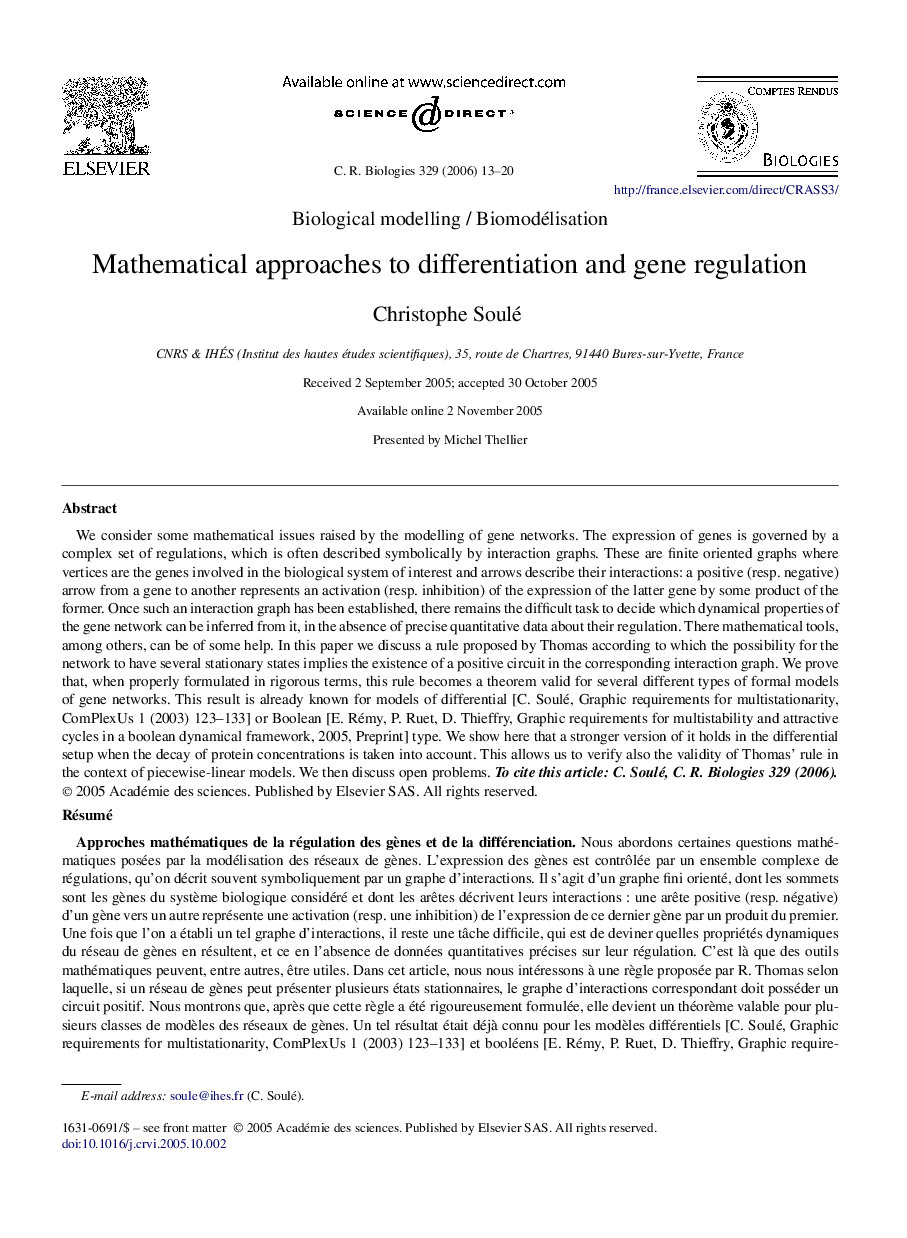| Article ID | Journal | Published Year | Pages | File Type |
|---|---|---|---|---|
| 2784632 | Comptes Rendus Biologies | 2006 | 8 Pages |
We consider some mathematical issues raised by the modelling of gene networks. The expression of genes is governed by a complex set of regulations, which is often described symbolically by interaction graphs. These are finite oriented graphs where vertices are the genes involved in the biological system of interest and arrows describe their interactions: a positive (resp. negative) arrow from a gene to another represents an activation (resp. inhibition) of the expression of the latter gene by some product of the former. Once such an interaction graph has been established, there remains the difficult task to decide which dynamical properties of the gene network can be inferred from it, in the absence of precise quantitative data about their regulation. There mathematical tools, among others, can be of some help. In this paper we discuss a rule proposed by Thomas according to which the possibility for the network to have several stationary states implies the existence of a positive circuit in the corresponding interaction graph. We prove that, when properly formulated in rigorous terms, this rule becomes a theorem valid for several different types of formal models of gene networks. This result is already known for models of differential [C. Soulé, Graphic requirements for multistationarity, ComPlexUs 1 (2003) 123–133] or Boolean [E. Rémy, P. Ruet, D. Thieffry, Graphic requirements for multistability and attractive cycles in a boolean dynamical framework, 2005, Preprint] type. We show here that a stronger version of it holds in the differential setup when the decay of protein concentrations is taken into account. This allows us to verify also the validity of Thomas' rule in the context of piecewise-linear models. We then discuss open problems. To cite this article: C. Soulé, C. R. Biologies 329 (2006).
RésuméNous abordons certaines questions mathématiques posées par la modélisation des réseaux de gènes. L'expression des gènes est contrôlée par un ensemble complexe de régulations, qu'on décrit souvent symboliquement par un graphe d'interactions. Il s'agit d'un graphe fini orienté, dont les sommets sont les gènes du système biologique considéré et dont les arêtes décrivent leurs interactions : une arête positive (resp. négative) d'un gène vers un autre représente une activation (resp. une inhibition) de l'expression de ce dernier gène par un produit du premier. Une fois que l'on a établi un tel graphe d'interactions, il reste une tâche difficile, qui est de deviner quelles propriétés dynamiques du réseau de gènes en résultent, et ce en l'absence de données quantitatives précises sur leur régulation. C'est là que des outils mathématiques peuvent, entre autres, être utiles. Dans cet article, nous nous intéressons à une règle proposée par R. Thomas selon laquelle, si un réseau de gènes peut présenter plusieurs états stationnaires, le graphe d'interactions correspondant doit posséder un circuit positif. Nous montrons que, après que cette règle a été rigoureusement formulée, elle devient un théorème valable pour plusieurs classes de modèles des réseaux de gènes. Un tel résultat était déjà connu pour les modèles différentiels [C. Soulé, Graphic requirements for multistationarity, ComPlexUs 1 (2003) 123–133] et booléens [E. Rémy, P. Ruet, D. Thieffry, Graphic requirements for multistability and attractive cycles in a boolean dynamical framework, 2005, Preprint]. Nous prouvons ici qu'une version plus forte de ce théorème est valable dans le cadre différentiel si l'on tient compte du déclin des concentrations des protéines. Ce résultat permet de montrer que la règle de Thomas est aussi valable pour les modèles de type linéaires par morceaux. Nous présentons également plusieurs questions ouvertes. Pour citer cet article : C. Soulé, C. R. Biologies 329 (2006).
